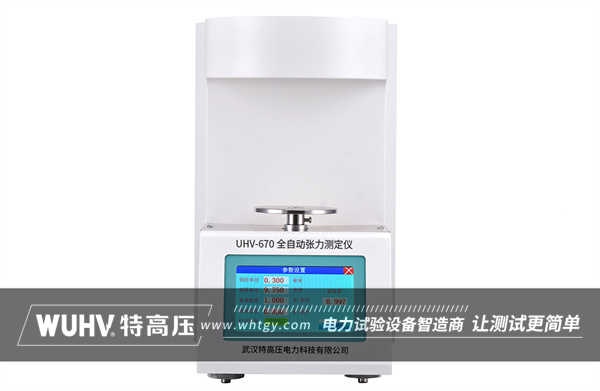The surface tension testerunder the UHV power company can help many power workers conduct various power tests more conveniently.

Surface tension has a wide range of applications in physics, and the following are some of the main application areas and examples:
Research on Liquid Surface Morphology:
The automatic shrinking trend and shape change of liquid surfaces, such as the spherical shape of water droplets, is due to the effect of surface tension. This phenomenon is commonly used in physics to study the surface morphology of liquids and their relationship with surface tension.
Capillary phenomenon:
The capillary phenomenon is the result of surface tension acting on small pipe diameters. For example, the height at which water rises or falls in a thin tube is related to the diameter of the tube and the surface tension of the liquid. This phenomenon has applications in biology, chemistry, and engineering, such as water transport from plant stems and ink transfer at pen tips.
Infiltration and non infiltration phenomena:
Infiltration refers to the phenomenon where a liquid can completely or partially cover the surface of a solid when in contact with it. Non wetting is the opposite, as liquids cannot form close contact with solid surfaces. These phenomena are related to the properties of solid surfaces and the surface tension of liquids, and are of great significance for understanding the behavior of liquids on solid surfaces.
Coating technology:
During the coating process, surface tension affects the flowability and distribution of the coating. By controlling surface tension, a more uniform and precise coating effect can be achieved. For example, in printing, painting, and coating technologies, it is necessary to adjust the surface tension of the coating to achieve the desired coating effect.
Application of surfactants:
Surfactants are a type of compound that can significantly reduce the surface tension of liquids. They are widely used in washing, emulsification, dispersion, foam stability and other fields. For example, in detergents, surfactants reduce the surface tension of water, making it easier for oil stains to be washed away by water.
Research on the Interface between Liquids and Gases:
Surface tension is the result of intermolecular interactions at the interface between liquid and gas. By studying surface tension, we can gain a deeper understanding of the properties and behaviors of liquid gas interfaces, such as bubble formation, stability, and rupture. This is of great significance for understanding the movement and distribution of bubbles in liquids, as well as the dissolution and diffusion of gases in liquids.
Experimental teaching:
Surface tension experiment is one of the important contents in physics teaching. Through experiments, students can intuitively observe the phenomenon of surface tension, understand its mechanism and influencing factors. For example, through coin small pool experiments, water float floating experiments, etc., students' interest in learning and exploratory spirit can be stimulated.
In summary, the application of surface tension in physics is mainly reflected in the study of liquid surface morphology, capillary phenomena, wetting and non wetting phenomena, coating technology, application of surfactants, interface research between liquids and gases, and experimental teaching. By delving into the properties and applications of surface tension, we can better understand the behavior of liquids and gases and their performance in practical applications.



















